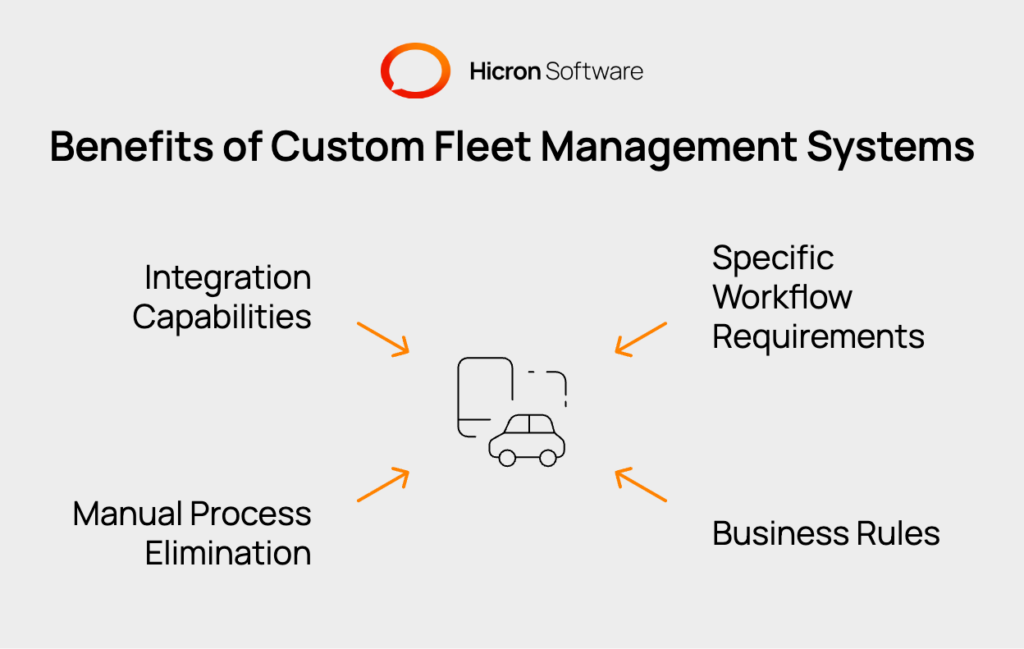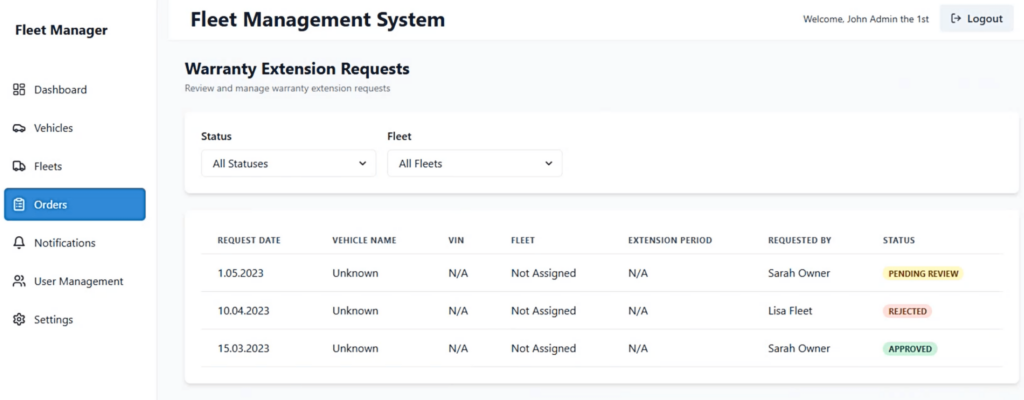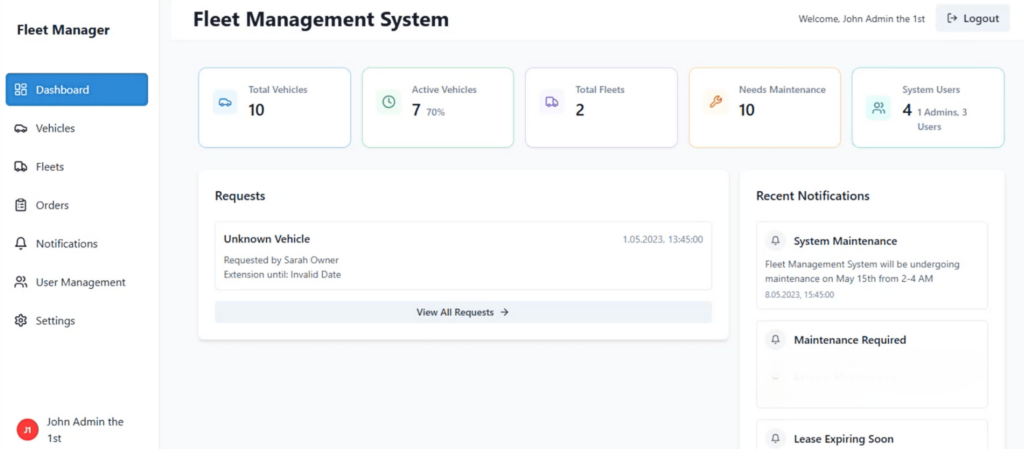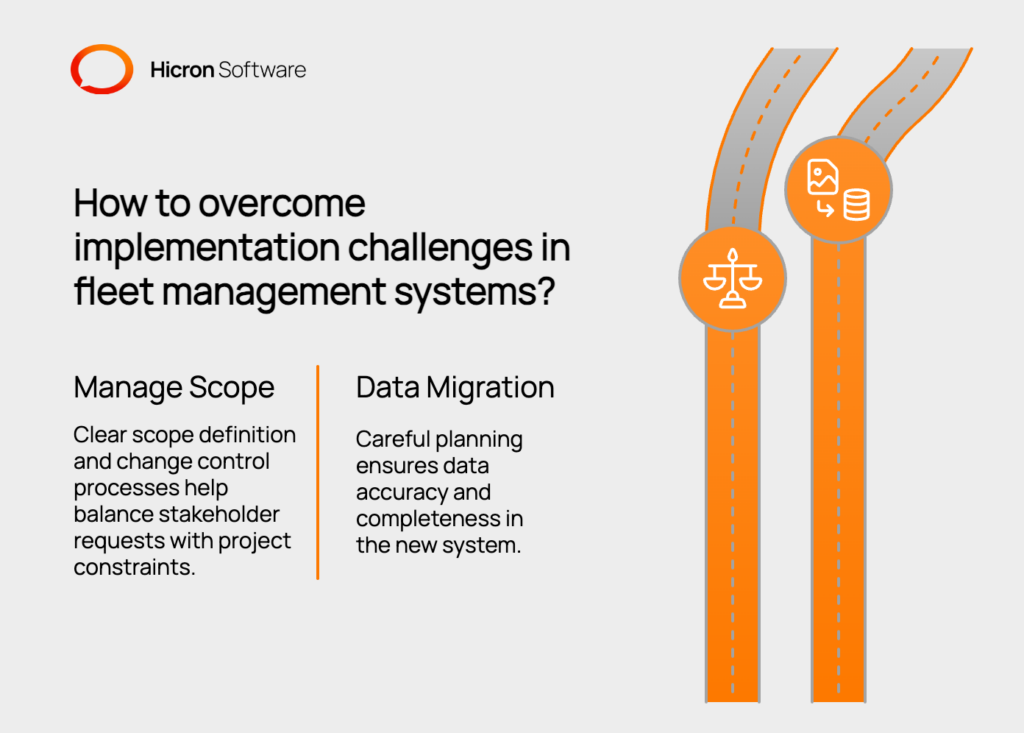Best Practices for Managing Automotive Warranty and After-Sales Services
- February 15
- 10 min

A custom fleet management system is a tailored software solution designed to meet the specific needs and requirements of a business that manages a fleet of vehicles. Unlike off-the-shelf fleet management software, a custom system is built from the ground up or heavily customized to align with the unique operational workflows, business rules, and goals of the organization.
Managing a fleet of vehicles has become increasingly complex as businesses expand their operations across multiple locations. Whether you’re overseeing delivery trucks, company cars, or demonstration vehicles, the challenges remain consistent: tracking vehicle locations, managing maintenance schedules, coordinating returns, and ensuring efficient operations. Many organizations still rely on outdated systems and manual processes that create bottlenecks and inefficiencies.
This comprehensive guide explores how to build a custom fleet management system that addresses these pain points while providing the flexibility to grow with your business needs.
Key takeaways:
A fleet management system serves as the central hub for all vehicle-related operations within an organization. Unlike generic solutions that offer one-size-fits-all approaches, a custom system can address specific workflow requirements and business rules that make your operation unique.
The primary value of building a custom solution lies in its ability to eliminate the manual processes that consume valuable time and introduce errors. Consider the typical scenario where fleet managers juggle multiple Excel spreadsheets, send countless emails for status updates, and struggle to maintain accurate records across different systems. These inefficiencies compound as fleet size grows, creating a need for automated solutions that can scale effectively.
Custom systems also provide better integration capabilities with existing business tools, allowing data to flow naturally between different departments and systems. This connectivity reduces duplicate data entry and ensures everyone works with the same accurate information.

The key features of the fleet management system are presented in the table below. They highlight how these core capabilities help optimize operations and improve overall efficiency. Use this overview to identify which essentials will add the most value to your fleet.
|
Feature |
Description |
|
Core Vehicle Tracking Capabilities |
|
|
Advanced Dashboard and Reporting |
|
|
User Role Management |
|
|
Automated Notification Systems |
|
The foundation of any effective fleet management system centers on comprehensive vehicle tracking. Real-time GPS integration allows fleet managers to monitor vehicle locations, track route efficiency, and respond quickly to unexpected situations. However, tracking goes beyond simple location data.
Vehicle lifecycle management represents another critical component. This includes tracking when vehicles enter the fleet, their assigned purposes, maintenance history, and eventual disposition. For organizations that rotate vehicles between locations or purposes, the system must handle complex assignment patterns and timing requirements.
Status management becomes particularly important for fleets with varying operational states. Vehicles might be active in field operations, undergoing maintenance, awaiting assignment, or preparing for return to manufacturers. Each status change triggers different workflows and notification requirements.
Depending on the specific purpose of the system, it may also include a driver management module. Tools for monitoring driver performance, behavior, and compliance with safety regulations. Additionally, fuel consumption and expense tracking in the form of reports. Tailored to the user’s needs, they allow for fuel consumption optimization and operational cost management.
Custom dashboards provide fleet managers with real-time visibility into operations. These interfaces should be configurable based on user roles and responsibilities. A fleet administrator needs comprehensive oversight of all vehicles, while individual fleet owners might focus on their assigned vehicles and upcoming deadlines.
Effective dashboard design incorporates visual indicators that highlight urgent items requiring attention. Color-coded status indicators, countdown timers for vehicle returns, and alert notifications help prioritize daily tasks. The system should present information in digestible chunks while maintaining the ability to drill down into detailed views when needed.
Reporting capabilities must address both operational and strategic needs. Daily operational reports might focus on vehicle availability and immediate maintenance requirements, while strategic reports analyze fleet utilization patterns and cost optimization opportunities.
Different stakeholders require different levels of access and functionality. Fleet administrators need comprehensive system access to manage all vehicles, assign responsibilities, and configure system parameters. Fleet owners typically focus on their assigned vehicles, receiving notifications about maintenance schedules, return deadlines, and other vehicle-specific events. Below, we present two example dashboards for the fleet manager of a custom fleet management system:


The role-based system should also accommodate external users such as service providers, dealers, or regional managers who might need limited access to specific information. This granular permission structure ensures data security while enabling necessary collaboration.
Manual communication creates delays and increases the likelihood of missed deadlines. Automated notifications keep stakeholders informed about important events without requiring constant system monitoring.
These notifications should be contextual and actionable. Rather than generic alerts, the system should provide specific information about what action is needed and by when. For example, a notification about an upcoming vehicle return should include relevant details such as mileage requirements, inspection deadlines, and contact information for coordination.
Email integration remains important, but modern systems should also consider mobile notifications and dashboard alerts to ensure critical information reaches users through their preferred communication channels.

Modern fleet management systems rarely operate in isolation. They need to exchange data with existing business systems such as accounting software, customer relationship management platforms, and external service providers.
Well-designed APIs enable this data exchange while maintaining system security and performance. The API should support common data formats and authentication methods, making it easier for other systems to connect and share information.
Consider the various types of data that might flow in and out of the system. Vehicle information might come from
The integration architecture should accommodate these different data sources while maintaining data integrity.
Many organizations operate legacy systems that contain valuable historical data or serve other business functions. The new fleet management system must coexist with these existing tools while gradually reducing dependence on manual processes.
This might involve creating data bridges that synchronize information between systems or developing migration strategies that preserve historical data while transitioning to new workflows. The key is maintaining business continuity during the transition period.
Integration architecture must accommodate future growth and changing business requirements. As organizations expand their fleets or modify their operational models, the system should adapt without requiring complete reconstruction.
This includes designing database structures that can handle increased data volumes, API endpoints that support additional functionality, and user interfaces that remain responsive as user counts grow.
The development roadmap for a custom fleet management system and project phases consists of 6 distinct stages. This table outlines the key phases and activities for successfully implementing a custom fleet management system, from initial planning to ongoing support.
|
Phase |
Duration |
Key Activities |
|
Requirements Analysis and Planning |
2-4 weeks |
|
|
System Design and Architecture |
4-6 weeks |
|
|
Core Development |
10-14 weeks |
|
|
Integration and Testing |
3-4 weeks |
|
|
Deployment and Training |
2-3 weeks |
|
|
Ongoing Support and Enhancement |
Continuous |
|
The foundation of any successful fleet management system lies in thorough requirements gathering. This phase involves detailed interviews with stakeholders to understand current workflows, identify pain points, and document desired outcomes.
Business analysis should capture not just what users say they want, but also observe how they actually work. Often, the most valuable insights come from understanding the workarounds and manual processes that users have developed to cope with existing system limitations.
Documentation from this phase should include user personas, workflow diagrams, and detailed functional requirements. These artifacts serve as the reference point for all subsequent development decisions and help ensure the final system meets real business needs.
With requirements clearly defined, the design phase focuses on creating the technical architecture and user experience framework. This includes database design, API specifications, and user interface mockups.
The architecture decisions made during this phase have long-term implications for system performance, maintainability, and scalability. Consider factors such as expected user loads, data volumes, and integration requirements when selecting technologies and designing system components.
Prototyping plays a crucial role in validating design decisions. Interactive mockups allow stakeholders to experience the proposed user interface and provide feedback before development begins. This early validation prevents costly changes during later phases.
The development phase transforms designs into working software. This typically represents the longest portion of the project timeline, as it involves building all core functionality, implementing integrations, and ensuring system reliability.
Agile development methodologies work well for fleet management systems because they allow for iterative feedback and refinement. Regular demonstrations of working features help stakeholders understand the system’s evolution and provide input on usability and functionality.
Testing throughout the development phase prevents quality issues from accumulating. This includes unit testing of individual components, integration testing of system interfaces, and user acceptance testing of complete workflows.
Integration testing focuses on ensuring the fleet management system works correctly with existing business systems and external services. This phase often reveals unexpected compatibility issues or performance bottlenecks that require resolution.
User acceptance testing involves real users working with the system in scenarios that mirror their daily responsibilities. This testing validates that the system actually solves the problems it was designed to address and identifies any usability issues that might impede adoption.
Performance testing ensures the system can handle expected load levels without degrading user experience. This is particularly important for systems that will serve multiple locations or large numbers of vehicles.
Deployment strategies should minimize disruption to ongoing operations. This might involve phased rollouts that gradually transition users from old systems to new ones, or parallel operations that allow fallback options if issues arise.
User training must address not just how to use the new system, but also how it changes existing workflows. Users need to understand the business benefits of the new system and how it will make their jobs easier or more effective.
Documentation and support materials ensure users can reference system features and troubleshoot common issues independently. This reduces support burden and improves user confidence with the new system.
Fleet management systems require ongoing maintenance to address bug fixes, security updates, and evolving business requirements. Planning for this maintenance from the beginning ensures the system remains valuable over time.
User feedback collected after deployment often identifies opportunities for improvement or additional features that weren’t apparent during initial requirements gathering. A structured process for evaluating and implementing enhancements helps the system evolve with changing business needs.

Every organization has unique requirements that generic software cannot address. Custom development allows for features that specifically support your business model and operational requirements.
This might include:
The key is balancing customization with maintainability. Highly customized systems can become difficult and expensive to maintain over time, so it’s important to identify which customizations provide genuine business value versus those that simply replicate familiar processes.
Different users have different preferences and requirements for how they interact with the system. Customizable dashboards allow users to focus on the information most relevant to their responsibilities.
This includes
Power users might prefer dense information displays, while occasional users benefit from simplified interfaces that guide them through common tasks.
Mobile accessibility has become increasingly important as fleet managers spend more time away from traditional office environments. The system should provide mobile-optimized interfaces that support the most common field operations without compromising functionality.
Fleet operations often involve complex business rules about vehicle assignments, maintenance schedules, and return procedures. Rather than hard-coding these rules, fleet management can systems provide configuration options that allow business users to modify rules without requiring software development.
This might include
The configuration interface should be intuitive enough for business users while maintaining appropriate controls to prevent configurations that could compromise system integrity or performance.

Fleet management systems often grow in scope as stakeholders recognize additional opportunities for automation and improvement. While this enthusiasm is positive, it can lead to project delays and budget overruns if not managed carefully.
Clear scope definition and change control processes help balance stakeholder requests with project constraints. It’s often better to deliver a solid core system on schedule and add enhancements in subsequent phases rather than attempting to include every possible feature in the initial release.
Regular progress reviews and demonstrations help stakeholders understand system development progress and make informed decisions about scope changes.
Existing data often resides in multiple systems with different formats and quality levels. Successful migration requires careful planning to ensure data accuracy and completeness in the new system.
This includes identifying authoritative data sources, developing data cleansing procedures, and creating validation processes to ensure migrated data meets quality standards. Historical data might require special handling if it doesn’t conform to current business rules or data structures.
Testing data migration processes with representative data sets helps identify issues before full migration and reduces the risk of data loss or corruption.
Technical success doesn’t guarantee business success. Users must understand and embrace the new system for it to deliver expected benefits.
Change management should begin during the requirements phase by involving users in system design decisions. When users feel their input has been incorporated, they’re more likely to support the new system.
Training should focus on how the new system improves users’ daily work rather than just explaining system features. Highlighting time savings, reduced manual effort, and improved accuracy helps users understand the personal benefits of adopting the new system.
Successful fleet management systems should demonstrate measurable improvements in operational efficiency and cost management. Establishing baseline metrics before system implementation provides a reference point for measuring success.
Common metrics include time spent on administrative tasks, accuracy of vehicle status information, response time for maintenance scheduling, and compliance with return deadlines. These operational metrics should align with broader business objectives such as cost reduction or customer service improvement.
User satisfaction metrics also provide important feedback about system effectiveness. Regular surveys and usage analytics help identify areas where the system excels and opportunities for improvement.
Fleet management needs evolve as businesses grow and operational requirements change. Planning for future enhancements from the beginning makes it easier to accommodate these changes without major system overhauls.
This includes designing flexible data structures that can accommodate new vehicle types or operational models, API architectures that can support additional integrations, and user interface frameworks that can incorporate new features without compromising usability.
Regular review sessions with stakeholders help identify emerging needs and prioritize enhancement opportunities based on business impact and technical feasibility.
Building a custom fleet management system requires careful planning, skilled development, and ongoing commitment to maintenance and improvement. However, organizations that invest in custom solutions often find they achieve better operational efficiency, reduced administrative burden, and improved visibility into their fleet operations.
The key to success lies in understanding your specific requirements, designing for flexibility and growth, and maintaining focus on solving real business problems rather than simply replicating existing processes in software. With proper planning and execution, a custom fleet management system becomes a strategic asset that supports business growth and operational excellence. Get in touch to start building your fleet management system.
A custom fleet management system is tailored to meet specific business needs, eliminating inefficiencies, integrating with existing tools, and providing scalability for future growth.
Key features include real-time GPS tracking, advanced dashboards, role-based access controls, automated notifications, and integration capabilities.
By automating manual processes, providing real-time data, and enabling better decision-making, it reduces administrative burdens and optimizes fleet operations.
The development process includes requirements analysis, system design, core development, integration and testing, deployment and training, and ongoing support.
Success requires thorough planning, user involvement, effective training, and a focus on addressing real business challenges rather than replicating existing processes.
